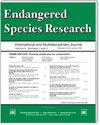Population genetics of freshwater stingray require investigation to confirm DNA contamination: Reply to Alshari et al. (2023)
IF 2.9
2区 环境科学与生态学
Q2 BIODIVERSITY CONSERVATION
引用次数: 0
Abstract
Alshari et al. (2023; Endang Species Res 50:311-313) were able to collect 3 Fluvitrygon kittipongi specimens from the Pahang River, which were not available to us at the time of our study (Lim & Then 2022; Endang Species Res 48:43-50). The cytochrome c oxidase I (COI) sequences (or haplotypes) of these 3 stingrays were identical to each other but differed from the haplotypes of our Perak River specimens. The result of 100% similarity between COI sequences of our Perak River rays and the eDNA water samples isolated from Pahang River in our study was suggested by Alshari et al. (2023) as DNA contamination in our study, which is plausible. However, further population genetics studies would be necessary to ascertain that the Perak River haplotype does not occur in stingrays of the Pahang River.淡水黄貂鱼的种群遗传学需要调查以确认DNA污染:回复Alshari et al. (2023)
Alshari et al. (2023;Endang Species Res 50:311-313)能够从彭恒河收集到3个Fluvitrygon kittipongi标本,这些标本在我们研究时是无法获得的(Lim & Then 2022;Endang Species Res 48:43-50)。这3种黄貂鱼的细胞色素c氧化酶I (COI)序列(或单倍型)相同,但与我们的霹雳河标本的单倍型不同。我们霹雳河射线的COI序列与我们研究中从彭亨河分离的eDNA水样100%相似的结果被Alshari et al.(2023)认为是我们研究中的DNA污染,这是合理的。然而,需要进一步的群体遗传学研究来确定霹雳河单倍型在彭恒河黄貂鱼中并不存在。
本文章由计算机程序翻译,如有差异,请以英文原文为准。
求助全文
约1分钟内获得全文
求助全文
来源期刊

Endangered Species Research
BIODIVERSITY CONSERVATION-
CiteScore
5.50
自引率
6.50%
发文量
38
审稿时长
31 weeks
期刊介绍:
ESR is international and interdisciplinary. It covers all endangered forms of life on Earth, the threats faced by species and their habitats and the necessary steps that must be undertaken to ensure their conservation. ESR publishes high quality contributions reporting research on all species (and habitats) of conservation concern, whether they be classified as Near Threatened or Threatened (Endangered or Vulnerable) by the International Union for the Conservation of Nature and Natural Resources (IUCN) or highlighted as part of national or regional conservation strategies. Submissions on all aspects of conservation science are welcome.
 求助内容:
求助内容: 应助结果提醒方式:
应助结果提醒方式:


